LESSON 17: "Snap It"
It is with great pleasure that I introduce to you some very interesting card effects and "wrinkles" with cards which CARDINI, the eminent English conjurer and master sleight of hand performer, has given me.
CARDINI is a marvel at novelty sleight of hand. It would be well worth your while to make a special effort to see him should he appear in any theater near you. He represents a magician of the new school. His every move is studied to the nth degree. He possesses that NATURALNESS in performing which I keep accenting and emphasizing. Many of his moves are intricate, but so finished an artist is he that to the audience things seem to happen in such an easy, spontaneous manner.
I mention this because I want you to study people of the stage. Note carefully the vast difference between the inexperienced amateur who presents his program in a jerky, hesitant manner and the seasoned professional who performs with a smoothness and naturalness which is intriguing. Observe the ease, the finish, the poise, the power of magnetism of the carefully trained actor. See how he stands, how he moves about the stage, how he performs with confidence and mastery. Not a move to mar or distract from the big effect which he seeks to put across to his audience.
Such performance is your goal. You are working for this perfection -- this NATURALNESS and PROFESSIONAL FINISH which will make you a MASTER.
1. "SNAP IT"
An impromptu effect which can be performed anywhere at a moment's notice. The finish leaves your audience thoroughly puzzled.
EFFECT:
A card is freely selected by a spectator, remembered, and returned to the deck. The performer shuffles the deck well, then drops it into a borrowed hat. A spectator is given the hat to hold. Magician snaps bottom of hat with his finger and high into the air jumps the selected card out of the hat.
PARAPHERNALIA:
1--A deck of cards.
2--A borrowed soft felt hat.
SECRET AND PATTER:
Ask a spectator to select a card freely, to remember it, and return it to pack. Divide deck into two sections, holding one in each hand. Have spectator place selected card on top of lower section in left hand. Insert little finger of left hand above this card. Pretend to place the two sections of deck together again.
Then perform the SIMPLIFIED PASS to get the selected card to top of deck, pretending to shuffle the deck thoroughly.

"If you don't mind, I shall use your hat for a moment."
Borrow a soft felt hat which has a crease in the crown.
Place the deck of cards inside of hat in the right hand groove formed by crease in crown of hat. Figure 1.
Now slide the Top card, which is the selected card over into the opposite left-hand groove in the crown of the hat. Figure 2.
There should be no hesitation or fumbling in sliding the selected card over to the opposite side. It should be done smoothly and very quickly. The audience must not see inside of hat and must be led to believe that you merely placed deck inside of it.
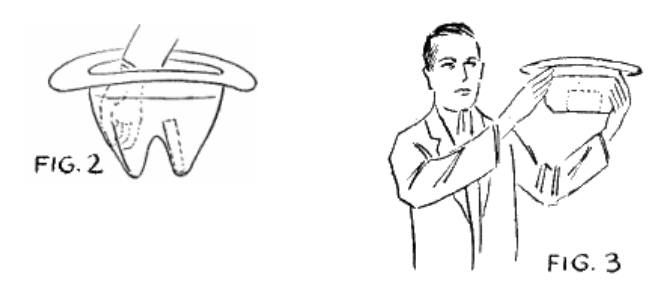
"Fifty-two little birds all packed in like sardines -- I'm getting birds and fish slightly mixed -- but, anyhow, these little birds are all tucked in their nest high up in the tree. Will you please hold the nest up in the tree?"
Give hat to spectator to hold by the brim. Have him hold it up high so that he cannot see what is inside. Figure 3.
"That's right -- nice and high just like this."
Adjust the hat so that the selected card is on the side nearest to you.
"What was the card you selected, sir? The Six of Diamonds?"
With index finger or second finger and thumb of right hand in position under left side of crown of hat where selected card is, prepare to snap it up. Figure 4.

"One little bird decided that sleeping fifty-two in a bed wasn't so good so he up and left the nest just like that."
As you say, "just like that," snap the hat under the selected card. The snap will send it high into the air. Figure 5.
"There you are. The Six of Diamonds."
If desired, performer may hold the hat himself with his left hand and snap the card out with his right. Figure 6.
2. FLASH CARD PRODUCTION
EFFECT:
Performer shows two wooden embroidery hoops. He places a sheet of tissue paper between them and pushes one hoop down over the other, forming a sort of tambourine. He then shows both sides of tambourine and his empty right hand. Suddenly he plunges his right hand through the paper and hoops, tearing the paper. Just as his hand appears through the paper a fan of cards is seen at his finger-tips.
PARAPHERNALIA:
1 -- A few cards.
2 -- Small wire clip such as is used to hold papers together.
3 -- Two wooden embroidery hoops, large enough for your hand to go through easily, about 8-1/2 inches in diameter.
4 -- Half-size sheet of tissue paper, colored.
SECRET AND PATTER:
To Prepare:
Take five cards and place them securely about half-way into the clip. Figure 7.
Sew top of wire clip inside of right side of your coat. Position of clip should be far enough up from lower edge of coat to have cards about three-quarters of an inch from bottom of coat when it hangs naturally. Figure 8.
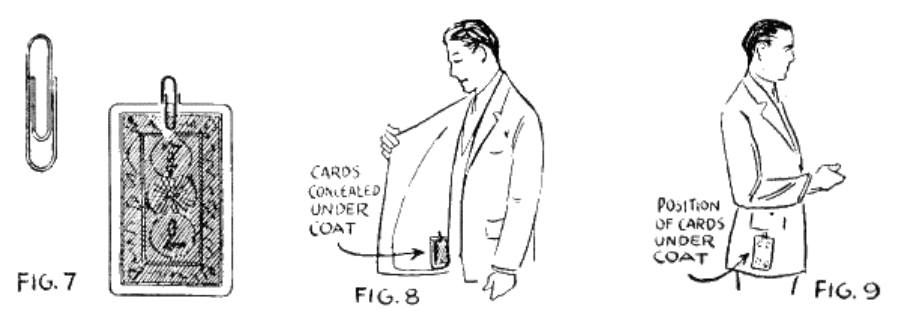
Figure 9 also shows position of cards under coat. They should be far enough from front edge of coat to enable you to reach them easily by curling your fingers up under your coat when your right arm is dropped naturally at your side. Cards face outward. Figure 9.
Have the two embroidery hoops on the sheet of tissue paper on table. Tissue should be 14-1/2 x 20-1/2 inches.
To Perform:
This effect is most often used to blend in with other effects. It is very effective as a special opening for another trick in which a few cards are needed. Another excellent use for it is as a finish for the production of selected cards, duplicates of which have been forced.
CARDINI, himself, finds it valuable to use after having produced several fans of cards from the empty hand. He then picks up hoops and paper and pushing his hand through produces still another fan.
Cardini's trained skillful fingers can produce many cards at once. It is best to start with the production of a few, from three to five. Master this and then work up gradually to the production of many cards. Do the effect well with a few cards rather than bungle it with many cards. With practice will come greater and greater ability.
Pick up smaller hoop and sheet of tissue paper. Show paper, both sides and place it over the hoop. Pick up the larger hoop and press it down over the paper and other hoop to make a tambourine. Figures 10 and 11.
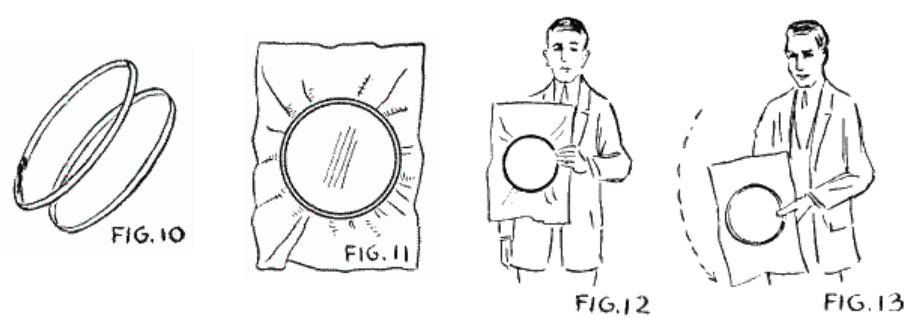
Do this away from the table and stand in a position to enable your audience to see clearly what you are doing. They must see that there is no trickery in this tambourine.
Hold tambourine with left hand. Outside of tambourine is toward audience. Right hand is held naturally at right side against the concealed cards under coat. Figure 12.
Turn tambourine over to show inside. The turning movement is made downward so that hoops come on a level with your right hand beside coat. Figure 13.
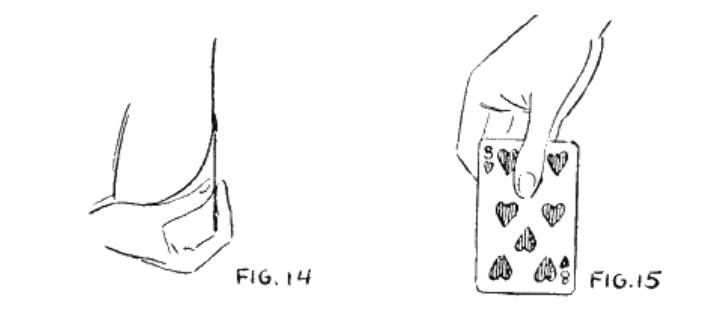
As soon as right hand is well screened with the paper, reach under coat and quickly remove the five cards. Figure 14.
Hand is drawn away with cards held as in Figure 15.
BACK HAND PALM:
The next move is to get the cards onto the back of the hand and hold them there so that they cannot be seen when front of hand is exposed to audience. This is an essential method of palming which must be mastered by every magician.
Move first and little fingers to sides of card so that card can be easily gripped between these two fingers. Figure 16, next page.
Remove thumb from card, grip card in first and little fingers, and curl back second and third fingers. Hold card as in Figure 17, next page.
Straighten out the fingers and the cards automatically go to back of hand. They are held there, gripped between first and second fingers and between third and little fingers. Figure 18 shows front and back views.
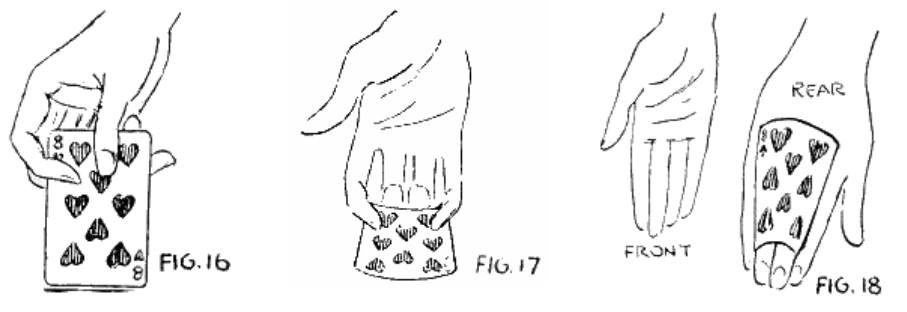
You must gain the ability to back palm like a flash. Start your practice using only one card, then as you gain greater skill in back palming, add more cards. The Back Palm must be done with one long, smooth, continuous movement to get card to back of hand, and then another move to bring card back to front again to be held as when you started the back palm, Figure 15.
After you have taken the cards from under coat, Back Palm them. Turn toward right a little so that your left side is toward audience. Bring hoop up so that outside is toward audience again.
Hold hoop as in Figure 19. Right hand is pulled behind it so that audience can see hand momentarily.
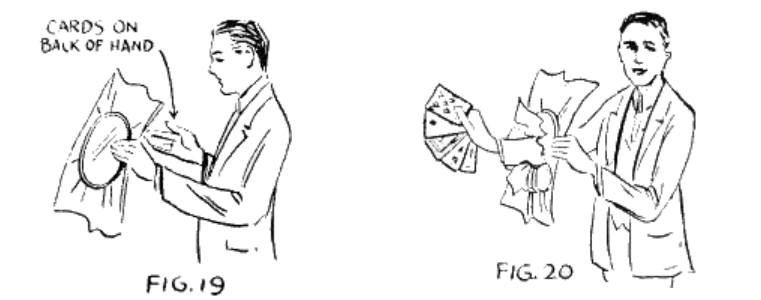
Then push right hand suddenly through the hoops, tearing the paper. The moment your hand is through the paper, bring the cards quickly from the back to the front of your hand by a reverse process (Figures 18-1716) so that they are held as in Figure 15. Grip cards with tips of fingers at the back and suddenly move your thumb upward. This move causes the cards to fan. Figure 20.
The effect must be that the fan appeared at your fingertips right out of the paper. It will take practice on your part to perfect this production. You must bring the cards to the front of your hand and fan them in a flash.
The effect is very startling when this fan of cards suddenly appears at the tips of your fingers. You can understand how any slowness or fumbling in producing the cards would completely spoil the experiment. Practice then until you have it perfected to a nicety before you perform it before an audience.
As you acquire skill in this card production, add more cards to the number you produce.
NOTE:
Soft, unglazed Steamboat Cards are good for this type of work.
3. MYSTERY OF THE GLASS HOUSE
Another impromptu effect which leaves your audience thoroughly mystified. A clever and interesting experiment for parlor, club, or stage work.
EFFECT:
Performer requests that two spectators assist him, one standing at his left and the other at his right. Man at right selects a card, remembers it, and returns it to deck. Cards are then shuffled. Performer says he will cause selected card to appear on top of pack. He shows card but it proves to be the wrong one. Magician then isolates this card in a glass tumbler. He gives spectator an empty envelope to examine and seal. Assistant at left is then given the deck of cards and spectator at right is asked to think of any number between one and twenty. Suppose he says — Twelve. Magician says if the card in the glass is not the selected card, then the twelfth card must be the one. Spectator counts down to twelve, but the card there is also an indifferent card. Glass is then turned around and selected card is found to be there instead of the indifferent one placed there. Envelope is torn open and the card that was placed in the glass is taken from the envelope.
PARAPHERNALIA:
1 -- A deck of cards.
2 -- A glass tumbler (regular size)
3 -- An ordinary envelope -- about 3 1/2 x 6 inches in size.
SECRET AND PATTER:
To Prepare:
Have deck of cards, tumbler, and envelope on the table at your left and slightly back of you.
To Perform:
Ask two gentlemen to come up from audience to assist you Suppose their names are Jones and Brown.
Have Jones stand at your left and a little in front of you, and Brown in a similar position at the right. Be sure that assistants do not screen your movements from the audience.
Pick up the cards, fan them, and ask Brown at your right to select any card, remember it, show it to audience, and return it to the deck.
After he has complied with your instructions, perform the SIMPLIFIED PASS to get the selected card to the top of the deck.
Then say to Brown, who has just selected card:
"It may seem quite remarkable, but the card you selected is having a difficult time in staying in the center of the deck and insists on coming to the top."
Lift up the "TWO" top cards and show as one. "That, sir, is your card, is it not?" Spectator, of course, denies this.
"No? That's strange. It must be. You are certain that it is not? If that's the case, I shall just isolate this card in this glass to keep it away from the other cards to prevent it from getting in the way again." Place the pack of cards on table.
Pick up glass with left hand and place the TWO cards in it, facing audience. Let us assume that the indifferent card which you showed to audience is the Six of Spades. The selected card is back of this card, but, of course, the audience is not aware of this. They think you have merely placed this one indifferent card in the glass. Figure 21, next page.
With right hand pick up envelope from table.
Say to Brown:
"Here is an envelope which I wish you to examine. See that it is empty and that there are no money orders, thousand dollar bills, or bathing suits present. Now, just seal it."
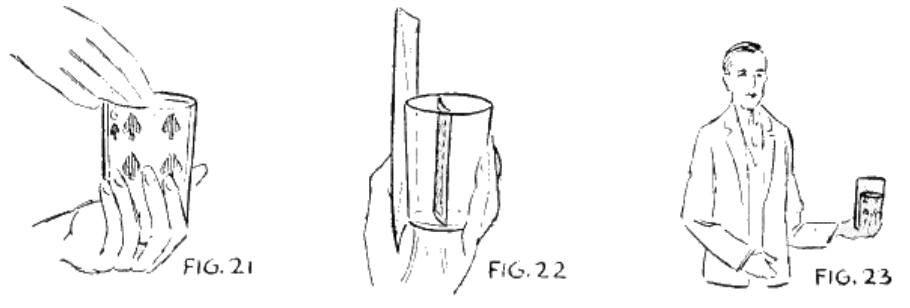
Take envelope with right hand and place it behind the glass which is still in left hand. Hold envelope against glass with left thumb. Figure 22.
Hold glass and envelope up in left hand so that audience can see card in glass. Pick up deck of cards with right hand and give it to Jones at left. Figure 23.
"Will you take the deck, sir?"
To Brown,
"And will you choose any number between one and twenty? Just any number. What is it? Twelve. Then if the card you selected is not the one in the glass, then it must be the twelfth card in the deck." To Jones.
"Will you count the cards one at a time and let us see the twelfth card?"
As you turn to ask Brown to select a number, you turn slightly to the right. This brings the glass and envelope around so that the envelope is in front of the glass and covers the glass and card. Figure 24.

As you speak to Brown, put right hand on top edge of envelope, fingers in front and thumb in back resting on Six of Spades. Figure 25.
As you speak to Jones, pull the Six of Spades up out of the glass behind the envelope. Use the envelope to accent gesture in talking and pointing to Jones.
It looks perfectly natural to pick up envelope for the gesture. Audience does not suspect that you have a card concealed behind it for they see the card in the glass and do not know you had two cards there. The back of the card in the glass is, of course, toward the audience and must be kept that way until the CLIMAX.
Hold envelope in right hand and glass in left hand while Jones counts down to the twelfth card. Figure 26.
Jones shows twelfth card. This, of course, is an indifferent card and not the one selected. To Brown,
"Was that the card you selected? No? This IS strange. You say the card in the glass is not your card nor is the twelfth card your card. According to the laws of Magic if the card does not appear at the number you selected, IT MUST BE THE ONE IN THE GLASS."
Turn the glass and show selected card in it instead of the Six of Spades which the audience saw there formerly. Suppose the selected card is the King of Hearts.
"Is that right?"
Set glass on table with left hand and with same hand remove the card.
"The King of Hearts was your card? Correct. What card did you think was in the glass? The Six of Spades? No . . ."
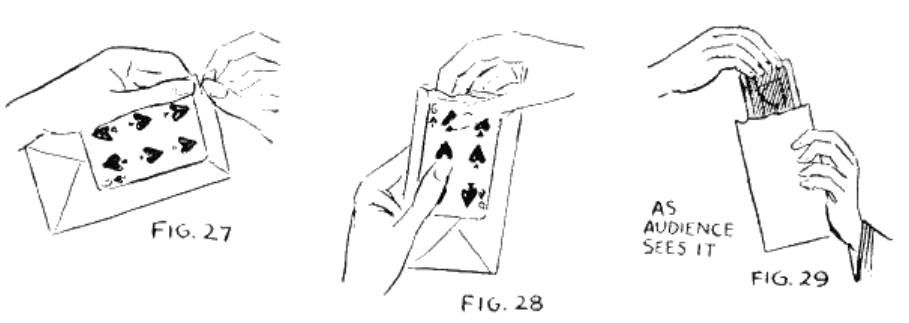
Drop the King on the table after saying, "Correct."
Place left hand on envelope and grasp card and envelope with fingers in front and thumb in back. With right hand tear off one end of envelope to open it. Figure 27.
With first and second fingers of right hand reach into envelope and open it up a little. You pretend that you are reaching into the envelope for something. The spectator knows that he sealed this envelope when it was empty. Figure 28.
Slant top of envelope back toward yourself a little so that audience cannot see top opening. Pull the card up from behind envelope. The effect is that you take the card from the inside of the envelope. Figure 29. "The Six of Spades is in the envelope."
LESSON 18
Your next lesson is tremendously interesting and valuable lesson. It is devoted to experiments with Rising Cards -- experiments which are fraught with mystery and entertainment.
Tarbell System, Incorporated, Chicago.
Bạn đang đọc truyện trên: truyentop.pro